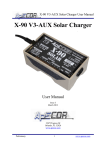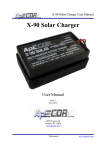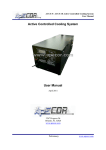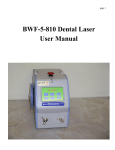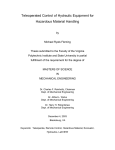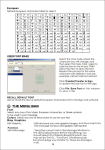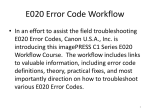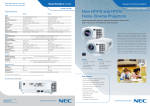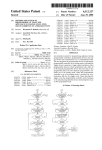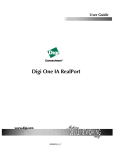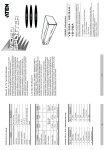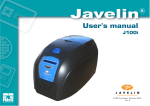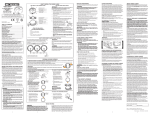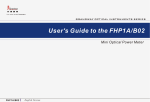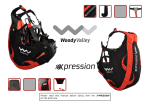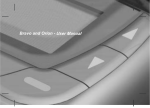Download X-90 Solar V3 User Manual 2013-03-29
Transcript
X-90 V3 Solar Charger User Manual X-90 V3-AUX Solar Charger User Manual Issue 3 March 2013 3267 Progress Dr Orlando, FL 32826 www.apecor.com Preliminary 1 www.apecor.com X-90 V3 Solar Charger User Manual Table of Contents General Information........................................................................................................................ 3 Introduction................................................................................................................................. 3 Features ....................................................................................................................................... 3 Specification Summary............................................................................................................... 4 Safety .......................................................................................................................................... 4 Solar Panel Selection & Input Power Considerations................................................................. 5 Battery Selection and Typical Operating Temperatures during Charging.................................. 5 Operation......................................................................................................................................... 7 Connections and Configuration ................................................................................................. 7 Charging Procedures................................................................................................................... 9 General Considerations for Maximum Charging and Battery Performance............................... 9 Special Considerations for Charging BB-2590 Li-Ion Batteries ................................................ 9 Special Considerations for Charging BB-590 NiCd Batteries.................................................... 9 Special Considerations for Charging BB-390 NiMH Batteries.................................................. 9 Typical Charging Times ........................................................................................................... 10 Label and LED Status Indicators .............................................................................................. 11 LED Status Information............................................................................................................ 11 Troubleshooting ........................................................................................................................ 12 Maintenance.............................................................................................................................. 12 Features ......................................................................................................................................... 13 Fast Maximum Power Point Tracking (MPPT) ........................................................................ 13 Reverse Polarity Protection (Electrically and Mechanically)................................................... 13 Temperature Protection............................................................................................................. 14 Over Current Protection............................................................................................................ 14 Automatically Dimming LED Indicators.................................................................................. 14 Warranty Statement ...................................................................................................................... 15 Claim Procedure........................................................................................................................ 15 Warranty Exclusions and Limitations....................................................................................... 15 Preliminary 2 www.apecor.com X-90 V3 Solar Charger User Manual General Information Introduction The X-90 V3 Aux Solar Charger is a portable solar battery charger capable of fast charging a wide array of typical portable rechargeable batteries, while also providing uninterruptable DC voltage for operating numerous devices. The charger features numerous advanced and proprietary digital control algorithms, which enables automatic battery detection, maximum power point tracking (MPPT) of the solar panel, value-added features and "X-90 Smart Adapters". The charger is able to operate from any solar panel configuration with Vopen circuit < 60V. The charger directly plugs onto the top of the supported batteries, and the only wiring needed is the connection to the solar panel or DC source using a polarized SAE plug. The advanced charge controller minimizes charge time by charging two battery strings simultaneously, while monitoring critical parameters to ensure safety and reliability. The implementation of high-speed MPPT delivers maximum charging current, even in low light or poor weather conditions. The simple LED interface informs the user when the batteries have been completely charged, if there are any fault conditions, and an estimate of the amount of time remaining until the battery is fully charged or discharged (depending on operating conditions). Features ♦ Maximum Power Point Tracking Up to 30% more power ♦ Universal Charging Algorithm Identifies chemistry automatically ♦ No User Input Required ♦ Fully Ruggedized Design ♦ Field Replaceable Sense Pins ♦ Fully Protected, including Reverse Polarity, Over Temperature, Active Current Limiting, and MIL-810F Compliant ♦ 12V or 24V Solar Panel Input - No Minimum/Maximum Solar Panel Wattage ♦ Polarized SAE plug to connect to solar panel or source ♦ Available extension input cable for use with other solar panels or DC sources ♦ Available “Y” adapter, to parallel multiple solar panels for maximum charge speed ♦ Compatible with "Smart X-90" adapters, allowing expanded operation with numerous batteries and adapters ♦ Auto dimming LED indicators reduce the LED Supported batteries Chemistry brightness when there is no input power BB/UBI-2590/U Li-Ion BB-590/U BB-390B/U UBBL09 UBBL36 X-90 Smart Adapter Preliminary 3 NiCd NiMH Li-Ion Li-Ion Numerous www.apecor.com X-90 V3 Solar Charger User Manual Specification Summary Maximum Input Voltage * Minimum Input Voltage Rated Charge Current Maximum Ambient Temperature Converter Efficiency * 60V 20V 8A (total), 4A per battery string 60°C 96%+ The solar panel’s open circuit voltage VOC must not exceed the maximum input voltage. Safety This manual contains important safety and operating instructions for the X-90 Solar Battery Charger. Read all the instructions and cautions of this manual and on the label of the X-90 before using it. To reduce the risk of electrical shock, fire, or injury operate charger in only the prescribed manner and use only with recommended items. General Safety Guidelines: • Observe polarity according to the label when connecting to the input. • Do not apply voltages higher than 60V on the input. • ONLY connect suggested batteries or X-90 smart adapters to the bottom of the X-90. • NEVER apply any other power sources or loads to the bottom connections of the X-90. • Only use recommended accessories with the X-90. • Only charge recommended batteries; not doing so may result in fire, electrical shock, or injury. • Do not charge a battery if the ambient temperature is outside of the recommended battery temperature limits. • Disconnect the X-90 cables by pulling on the plug, not the cord. • Do not use the X-90 with damaged cables or connector pins. • Check for proper electrical connections to the cables and battery to avoid excessive heating and power loss from a loose or dirty connection. • Do not try to operate the X-90 if there is any visible damage. • Do not operate multiple X-90 units from a single solar source, when using solar power the panels should be separate for each X-90. It is permissible to use a single DC source, as long as the power rating is great enough to supply all connected X-90 units. • Do not remove the X-90 unit from a charging battery to “check the progress” by looking at the state of charge indicator of the battery. This will reset the charge algorithm and increase the charge time. The X-90 unit will inform the user when the battery is fully charged. Preliminary 4 www.apecor.com X-90 V3 Solar Charger User Manual Solar Panel Selection & Input Power Considerations Use “12V” or “24V” solar panels or any other panel as long as its maximum power voltage (Vmp) is greater than 17V and its open circuit voltage (Voc) is below 60V. If available, the X-90 will use up to ~140W to charge a BB-2590 with its maximum rated charge current or ~65W for a BB-390 / BB-590. The available SAE Y cable can be used to parallel two solar panels in order to increase charge speed. There is no minimum input power requirement, but charge speed will decrease when used with lower power solar panels. A list of recommended panels is shown in Table 1 below. Company Global Solar Energy, Inc. Part # P3 124W 12V P3 124W 24V P3 62W 12V P3 62W 24V P3 30W 12V P3 30W 24V Max. Power @ 25°C 124W 124W 62W 62W 30W 30W Nominal System Voltage 12V 24V 12V 24V 12V 24V Table 1: Recommended Solar Panels Battery Selection and Typical Operating Temperatures during Charging Table 2 shows a list of BB-XX90 type batteries that can be charged with the X-90. Make sure that each battery is charged at its allowable ambient temperature range which is typically between 5°C (41°F) and 38°C (100°F). Refer to the label on each battery for exact values. Please note that the datasheets of most of the batteries list only the operating and storage temperature ranges which are more extended and not the same as the charging temperature range! BB-2590 SMBus BB-2590/U BB-390A/U or BB-390/U BB-590/U BB-2590/U BB-390B/U BB-590/U Charge Current (per string) 4A 3.2A * 2A 2A 4A 2A 2A Patco Electronics Inc. BB-2590/U 4A Li-Ion 14.4/28.8 UltraLife Batteries UBBL02 (UBI-2590) UBBL10 (UBI-2590 SMBus) UBBL09 (UBI-2590 12V/24V) UBBL36 (1/2 UBI-2590) UBBL13 (UBI-2590 HC) 3.2A * 3.2A * 3.2A * 3.2A * 3.2A * Li-Ion Li-Ion Li-Ion Li-Ion Li-Ion 14.4/28.8 14.4/28.8 12V/24V 14.4V 14.4/28.8 Company Mathews Associates, Inc. Bren-Tronics Part # Chemistry Voltage Li-Ion Li-Ion NiMH NiCd Li-Ion NiMH NiCd 14.4/28.8 14.4/28.8 12.0/24.0 12.0/24.0 14.4/28.8 12.0/24.0 12.0/24.0 Table 2: Recommended Batteries **Due to design or protection limitations, certain Li-Ion batteries cannot be charge at the full 4A capability of the X-90 V3. These batteries are detected and charged at a safe 3.2A current level. This will increase the charge time for the affected batteries. Preliminary 5 www.apecor.com X-90 V3 Solar Charger User Manual Available X-90 Smart Adapters The X-90 V3 includes the capability to use adapter cables connected to the 6-pin XX90 barrel connector to allow the charging of numerous other batteries and accessories. The adapters communicate with the X-90 V3 to indicate the type of adapter connected, so as to allow the X-90 to implement the proper charge algorithm. ApECOR has the capability to provide specific charging solutions for nearly all battery types, please contact us at [email protected] to request specific charging capability. Preliminary 6 www.apecor.com X-90 V3 Solar Charger User Manual Operation Connections and Configuration There are basically two main methods to power the X-90 for charging the BB-XX90 type batteries: Solar panels (see Figure 16 and Figure 27) or a DC source such as other batteries (Figure 38 to Figure 510). The most common setup is with one solar panel connected. To increase charging speed or if clouds are limiting available power, solar panels can be paralleled. If available, the X-90 will use up to ~140W input power for BB-2590 batteries or up to ~65W for BB-390 and BB-590 batteries to charge them at their respective maximum charge currents. Other batteries can be used as power sources as long as they fulfill the input voltage and power requirements of the X-90. A 24V vehicle bus or two 12V lead-acid batteries in series could serve as a power source. Furthermore, if there is at least one partially discharged BBXX90 battery available, it could potentially be used to recharge another BB-XX90, so that at least one battery is fully charged for a mission. Figure 1: Charger Setup 1 with one Solar Panel as power source Figure 2: Charger Setup 2 with two Solar Panels in parallel as power source Preliminary 7 www.apecor.com X-90 V3 Solar Charger User Manual Figure 3: Charger Setup 3 with one 24V Battery as power source * Figure 4: Charger Setup 4 with two 12V batteries in series as power source * Figure 5: Charger Setup 5 with one BB-x90 Battery as power source * * using optional accessories Preliminary 8 www.apecor.com X-90 V3 Solar Charger User Manual Charging Procedures Connect the X-90 to the power source to be used and the battery to be charged in any order. If the LEDs on top of the charger are still lit up from a previous charge, wait until all lights are off before connecting to another battery. Once everything is connected together, the LEDs will blink at different speeds meaning that the X-90 is analyzing the connected battery for about 2 - 5 seconds to determine its chemistry. If there was no fault, the “Status LED” will continue to blink, indicating that the battery is charging. The “85% Charged LED” only lights up when a BB-2590 (Li-Ion) is connected and its capacity reached about 85% of the total capacity. The charge is finished once the “Status" LED is on. Then the battery and/or power source can be disconnected or another battery can be charged. General Considerations for Maximum Charging and Battery Performance Align solar panel perpendicular to the sun and avoid shading of the panel whenever possible for maximum power. Place the X-90 with the battery in the shade wherever possible, especially at high ambient temperatures. Even though the X-90 won’t be damaged when exposed to full sun while charging, the battery has lower maximum temperature limits while being charged that are typically around 38°C (100°F). One simple method of shading the X-90 while charging is to place it underneath a rucksack. Special Considerations for Charging BB-2590 Li-Ion Batteries Besides the “Status LED” there is also a “85% Charged LED” for BB-2590 batteries. It will come on once approximately 85% of the battery’s full capacity is reached. To charge the last 15% it will take about 30 to 40% of the total charge time! If there are more batteries to be charged, it makes sense to take off the current battery and to charge another fully depleted BB-2590 which could be charged to ~50% in the same time. This allows the user to have a higher overall state of charge for all the batteries instead of only having one battery completely charged. Special Considerations for Charging BB-590 NiCd Batteries The BB-590 battery is the hardest to accurately be charged to its full capacity using a variable power source such as a solar panel. In order to use the full potential of the charge algorithm implemented in the X-90, the following things have to be considered: • Don’t charge a battery if it is already known to be full. In some conditions a fully-charged battery might overheat if charged again. If possible, record the date of the last full charge of the battery and use it before recharging again. • If possible, discharge the two battery strings inside the BB-590 equally. Don’t repeatedly unplug the X-90 and connect it back to the battery. Those conditions might confuse the X-90 and it might terminate the charge too early. Special Considerations for Charging BB-390 NiMH Batteries The BB-390 has an internal temperature sensor which allows the X-90 to charge the battery more accurately and protect it from over-charge. Prior to charging, the battery should be kept in a cool place because the charge cannot be started if its temperature is already above 40°C (104°F) in order to protect the battery from over-temperature. Therefore it is also not recommended to repeatedly unplug the X-90 from the battery and put it back on only to see the state-of-charge display. This is because once the battery’s temperature during charge is above 40°C (104°F) the X-90 will not start charging the battery again unless its temperature has dropped below that point. Preliminary 9 www.apecor.com X-90 V3 Solar Charger User Manual Typical Charging Times Battery Chemistry Capacity (Ah) Max Charge Current BB-2590 Li-Ion 14.4 4A/String(1) BB-390 BB-590 NiMH NiCd 9.8 4.8 2A/String 2A/String UBBL09 Li-Ion 18.4 4A/String UBBL36 Li-Ion 8.7 4A Solar Panel (Watts) 62 124 DC Source 62 62 62 124 DC Source 62 Typical Full Charge Time (Hours) 4.5 (3 hrs 85%) 2.65 (1.75 hrs 85%) 2.5 (1.5 hrs 85%) 3 1.5 5.25 3.25 3 2.75 (2 hrs 85%) Table 3: Typical Charging Times Notes: (1) Only applies when charging certain BB-2590 type batteries. Depending on the design limitations imposed by various manufacturers, the X-90 will automatically charge some BB-2590 type batteries at 3.2A per string. Preliminary 10 www.apecor.com X-90 V3 Solar Charger User Manual Label and LED Status Indicators LED Status Information Fault Status 85% Charged Red Green Green Off Off Off Off Off Blinking (2) Off On On/ Blinking - Meaning Action to take Ready to connect Charging Connect battery Optional: Disconnect battery and connect a lower charged battery. In Charging, battery is On (1) the time it takes to charge the last (1) 85% full 15%, the first 50% of an empty battery could be charged. (1) On Finished charging Disconnect battery Check connections, make sure that Fault, converter not operation of converter is within the running maximum ratings Table 4: LED status information Notes: (1) Only applies when charging Li-Ion (2) Blinking speed changes based on charging current: ~ (0.5 to 20) blinks/sec for a total charge current of (0 to 8) A Preliminary 11 www.apecor.com X-90 V3 Solar Charger User Manual Troubleshooting Condition Fault light blinking for a long period of time Possible Causes Input power may be low Solutions Wait for more sunshine Orient panel perpendicular to sun Table 5: General Trouble Shooting Condition X-90 finishes charge but state-of-charge display doesn’t show all 5 bars 85% light turning on and off Possible Causes The X-90 might have stopped early because of changing input power Internal battery SOC meter not accurate Solutions Unplug X-90 from the battery and plug back onto it to top off battery A full discharge and charge cycle of the battery might recalibrate the gauges Available power changes a lot while This is normal, no action needs to be battery is approximately 85% done taken Table 6: Trouble Shooting for BB-2590 (Li-Ion) Condition There is no power available from battery after finished charging Possible Causes Battery was charged at higher temperatures than recommended which triggered an internal safety switch Condition X-90 finishes charge but state-of-charge display doesn’t show all 5 bars Possible Causes Solutions The battery hasn’t been discharged Discharge battery completely before completely for a longer period of time charging again which causes offsets Find a cool and ventilated place to charge Battery temperature got too high the battery because of ambient temperature being (Battery temperature needs to be below above 38°C (100°F), therefore charge 40°C (104°F) for the X-90 to start was terminated early to protect the charging again) battery Temperature of battery is above 40°C Let battery cool down, X-90 will start (104°F) charging battery once temperature is good Table 8: Trouble Shooting for BB-390 (NiMH) Fault light blinking Solutions Let battery cool down, after it cools power will be available again. Make sure that battery is not being charged beyond recommended charging temperatures. Table 7: Trouble Shooting for BB-590 (NiCd) Maintenance The X-90 has no user serviceable parts except for the spring sense pins. Check for broken, corroded, or otherwise damaged cable or battery contacts. Make sure that all battery contacts are straight and that the three spring pins can be pushed in and come out again if released. If a defect has been found, discontinue use of the X-90 and contact ApECOR. The input cable may be repaired if necessary; however do NOT attempt to repair battery contacts. Make sure that all contacts are free of mud, dirt, dust, oil and grease. If found dirty, they can be cleaned with a damp non-abrasive cloth and allowed to air dry or wiped with a clean dry non-abrasive cloth. In case of oils and grease, use a mild soap/water solution on a cloth to clean the contacts, then rinse the contacts with water. If a spring sense pin is damaged, contact ApECOR to purchase a spring pin replacement kit. This can allow the user to make the repair without returning the X-90 unit. Preliminary 12 www.apecor.com X-90 V3 Solar Charger User Manual Features The X-90 has many features that enhance its core functions, make it safer to operate and increase its reliability and performance. Fast Maximum Power Point Tracking (MPPT) A solar panel has a unique characteristic that is derived from the fact that as more current is drawn from the solar panel the more the voltage will decrease. The respective curves (IV – Current vs. Voltage, PV – Power vs. Voltage) in Figure 611 show that at a certain voltage the available power has a maximum. Typical battery chargers use the battery’s voltage to select where the solar panel is operating on the curve and this point of operation is mostly lower than the maximum power point (MPP). Figure 6: IV and PV curves for a typical solar panel The X-90 uses an advanced version of MPPT which is constantly running to make sure that it always operates at the MPP of the panel. This makes the X-90 superior to other MPPT battery chargers that look for the MPP every once in a while. This is because the X-90 finds the new MPP very quickly during changing conditions whereas other MPPT chargers don’t operate at the new MPP until their next scan. This is especially important during days with lots of clouds and wind which lead to fast variations in available power. Since the X-90 can operate longer at the maximum power than other chargers, it can charge the battery faster. The changes in available solar power reaching the panel is usually shading caused by objects blocking the sun such as clouds, people, or trees. If there is more power available from the solar panel than needed to charge the respective battery, then the X-90 will drop out of MPPT mode. This can happen for all batteries if there is a higher power solar panel connected or it could mean that the battery (only for BB-2590 batteries) is nearly full. Reverse Polarity Protection (Electrically and Mechanically) In order to protect the entire system the X-90 has a reverse polarity protection (RPP) on the input and output connections. If there is no positive voltage seen on the terminals of the X-90, it won’t allow any current to flow, which is the electrical RPP. In addition, there is a mechanical RPP which means that the solar panel and battery cannot be plugged in the wrong way. Even though the input and output ports have reverse polarity protection, care should be taken to observe the indicated polarity on the wires to assure a proper connection. Preliminary 13 www.apecor.com X-90 V3 Solar Charger User Manual Temperature Protection The X-90 provides the full charge current up to a certain internal temperature. Above that temperature it will linearly de-rate the charge current up to a maximum allowable internal temperature in order to protect its circuitry to safe limits. The auxiliary output circuit also features temperature protection independent of the battery charging protection functions. If the auxiliary output is overloaded, and the temperature protection trips, the battery will still continue to charge. After the temperature has fallen to an acceptable level, the functionality will resume. Over Current Protection The X-90 is protected against over-current and short circuit conditions. Normally, it will limit the maximum charge current to 4A for a BB-2590 battery or to 2A for a BB-390 / BB-590 battery. If under some condition the current exceeds that value a fault may be triggered. After a fault, the software of the X-90 can successfully reset the fault in case it was only a temporary condition. If in the case of a failure where the high current could not be stopped because the circuitry of the X-90 is damaged, an internal fuse will break and disconnect from the battery. In that case the X-90 would be permanently non-operational. This behavior is preferred, as the battery is protected from short circuit currents that could have led to a catastrophic failure of the battery. Automatically Dimming LED Indicators The X-90 will automatically reduce the brightness of the LED indicators to approximately 30% of the maximum brightness when there is no incoming power. When charging from a solar source, the LEDs are at full brightness, so as to be visible in the sun. In other cases the X-90 will save power by reducing the LED brightness, which can also serve to reduce excess light emission in dark environments. NOTE: In tactical environments, the soldier worn X-90 should be securely strapped into a pouch which will completely cover the indicator LEDs. Preliminary 14 www.apecor.com X-90 V3 Solar Charger User Manual Warranty Statement The X-90 Solar Charger is warranted to be free from defects in material and workmanship for a period of TWO (2) years from the date of shipment to the original end user. ApECOR will, at its option, repair or replace any such defective products. Claim Procedure • • • Before requesting warranty service, check the User Manual to be certain that there is a problem with the controller. Contact ApECOR to request Returned Material Authorization (RMA). Return the defective product to your authorized ApECOR distributor with shipping charges prepaid. Provide proof of date and place of purchase. To obtain service under this warranty, the returned products must include the model, serial number and detailed reason for the failure, the module type, solar panel size, type of batteries. This information is critical to a rapid disposition of your warranty claim. ApECOR will pay the return shipping charges if the repairs are covered by the warranty. Warranty Exclusions and Limitations This warranty does not apply under the following conditions: • Damage by accident, negligence, abuse or improper use. • PV or load currents exceeding the ratings of the product. • Unauthorized product modification or attempted repair. • Damage occurring during shipment. THE WARRANTY AND REMEDIES SET FORTH ABOVE ARE EXCLUSIVE AND IN LIEU OF ALL OTHERS, EXPRESS OR IMPLIED. APECOR SPECIFICALLY DISCLAIMS ANY AND ALL IMPLIED WARRANTIES, INCLUDING, WITHOUT LIMITATION, WARRANTIES OF MERCHANTABILITY AND FITNESS FOR A PARTICULAR PURPOSE. No ApECOR distributor, agent or employee is authorized to make any modification or extension to this warranty. APECOR IS NOT RESPONSIBLE FOR INCIDENTAL OR CONSEQUENTIAL DAMAGES OF ANY KIND, INCLUDING BUT NOT LIMITED TO LOST PROFITS, DOWNTIME, GOODWILL OR DAMAGE TO EQUIPMENT OR PROPERTY. 3267 Progress Dr. Orlando, FL 32826 Email: [email protected] Website: www.apecor.com Preliminary 15 www.apecor.com















